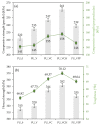Vermiculite Filler Modified with Casein, Chitosan, and Potato Protein as a Flame Retardant for Polyurethane Foams
- PMID: 34639165
- PMCID: PMC8509235
- DOI: 10.3390/ijms221910825
Vermiculite Filler Modified with Casein, Chitosan, and Potato Protein as a Flame Retardant for Polyurethane Foams
Abstract
In this study, polyurethane (PU) composite foams were modified with 2 wt.% of vermiculite fillers, which were themselves modified with casein, chitosan, and potato protein. The impact of the fillers on selected properties of the obtained composites, including their rheological (foaming behavior, dynamic viscosity), thermal (temperature of thermal decomposition stages), flame-retardant (e.g., limiting oxygen index, ignition time, heat peak release), and mechanical properties (toughness, compressive strength (parallel and perpendicular), flexural strength) were investigated. Among all the modified polyurethane composites, the greatest improvement was noticed in the PU foams filled with vermiculite modified with casein and chitosan. For example, after the addition of modified vermiculite fillers, the foams' compressive strength was enhanced by ~6-18%, their flexural strength by ~2-10%, and their toughness by ~1-5%. Most importantly, the polyurethane composites filled with vermiculite filler and modified vermiculite fillers exhibited improved flame resistance characteristics (the value of total smoke release was reduced by ~34%, the value of peak heat release was reduced by ~25%).
Keywords: burning behavior; flame retardants; high-ball milling process; polyurethane foams; vermiculite.
Conflict of interest statement
The authors declare no conflict of interest.
Figures











References
-
- Akindoyo J.O., Beg M.D.H., Ghazali S., Islam M.R., Jeyaratnam N., Yuvaraj A.R. Polyurethane types, synthesis and applications—A review. RSC Adv. 2016;6:114453–114482. doi: 10.1039/C6RA14525F. - DOI
-
- Joshi M., Adak B., Butola B.S. Polyurethane nanocomposite based gas barrier films, membranes and coatings: A review on synthesis, characterization and potential applications. Prog. Mater. Sci. 2018;97:230–282. doi: 10.1016/j.pmatsci.2018.05.001. - DOI
-
- Harikrishnan G., Patro T.U., Khakhar D.V. Polyurethane foam—Clay nanocomposites: Nanoclays as cell openers. Ind. Eng. Chem. Res. 2006;45:7126–7134. doi: 10.1021/ie0600994. - DOI
-
- Tikhani F., Shirkavand Hadavand B., Fakharizadeh Bafghi H., Jouyandeh M., Vahabi H., Formela K., Hosseini H., Reza Paran S.M., Esmaeili A., Mohaddespour A., et al. Polyurethane/Silane-Functionalized ZrO2 Nanocomposite Powder Coatings: Thermal Degradation Kinetics. Coatings. 2020;10:413. doi: 10.3390/coatings10040413. - DOI
MeSH terms
Substances
LinkOut - more resources
Full Text Sources

